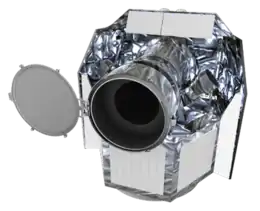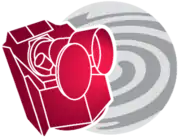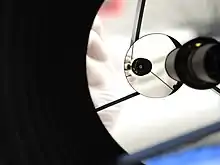CHEOPS
CHEOPS (CHaracterising ExOPlanets Satellite) is a European space telescope to determine the size of known extrasolar planets, which will allow the estimation of their mass, density, composition and their formation. Launched on 18 December 2019, it is the first Small-class mission in ESA's Cosmic Vision science programme.[13]
 An artist's impression of the CHEOPS space observatory. | |
| Mission type | Exoplanetology, astrophysics |
|---|---|
| Operator | Swiss Space Office ESA |
| COSPAR ID | 2019-092B |
| SATCAT no. | 44874 |
| Website | cheops sci |
| Mission duration | 3.5 years (nominal) Elapsed: 1 year, 1 month and 16 days |
| Spacecraft properties | |
| Spacecraft type | Space observatory |
| Bus | SEOSAT platform [1] |
| Manufacturer | Airbus Defence and Space (Spain) |
| Launch mass | 273 kg [2] |
| Payload mass | 58 kg [3] |
| Dimensions | 1.5 x 1.5 x 1.5 m |
| Power | 64 watts [4] |
| Start of mission | |
| Launch date | 18 December 2019 at 08:54:20 UTC [5] |
| Rocket | Soyuz VS23 [6]·[7] |
| Launch site | Centre Spatial Guyanais (Ensemble de Lancement Soyouz) |
| Contractor | Arianespace [8]·[9] |
| Orbital parameters | |
| Reference system | Geocentric |
| Regime | Sun-synchronous 06:00 / 18:00 |
| Perigee altitude | 712 km [10] |
| Apogee altitude | 715 km |
| Inclination | 92.8° |
| RAAN | 06:00 |
| Main telescope | |
| Type | Ritchey-Chrétien frame-transfer back-side illuminated CCD |
| Diameter | 32 cm [9] |
| Focal ratio | f/8 |
| Wavelengths | 330 to 1100 nm |
| Transponders | |
| Capacity | 1.2 Gbit/day downlink [11] |
| Instruments | |
| Photometer [12] | |
 The mission insignia. | |
The small satellite features an optical Ritchey-Chrétien telescope with an aperture of 30 cm, mounted on a standard small satellite platform. It was placed into a Sun-synchronous orbit of about 700 km altitude.
Science overview
Thousands of exoplanets have been discovered by the end of the 2010s;[14] some have minimum mass measurements from the radial velocity method while others that are seen to transit their parent stars have measures of their physical size. Few exoplanets to date have highly accurate measures for both mass and radius, limiting the ability to study the variety in bulk density that would provide clues as to what materials they are made of and their formation history.[15] For the planned mission duration of 3.5 years, CHEOPS is to measure the size of known transiting exoplanets orbiting bright and nearby stars [16] as well as search for transits of exoplanets previously discovered via radial velocity. Scientists behind the project expect these well-characterised transiting exoplanets to be prime targets for future observatories such as JWST or the extremely large telescopes.[17]
History

Organized as a partnership between the European Space Agency (ESA) and the Swiss Space Office, CHEOPS was selected in October 2012 from among 26 proposals as the first S-class ("small") space mission in ESA's Cosmic Vision programme.[16] ESA is the mission architect and responsible for the spacecraft and launch opportunity procurement. The project is led by the Center for Space and Habitability at the University of Bern, Switzerland, with contributions from other Swiss and European universities. The Principal Investigator for the science instrument is Willy Benz at the University of Bern and the Principal Scientist from ESA is Kate Isaak. After a competition phase, Airbus Defence and Space in Spain was selected as the spacecraft builder.[6][18] The ESA mission cost is capped at €50 million.[6] Media Lario S.r.l. (Italy) was responsible for the optical finishing of the primary optical element.[19]
Spacecraft
The satellite has dimensions of approximately 1.5 × 1.5 × 1.5 m and a hexagonal base structure. The bus of the CHEOPS spacecraft is based on the SEOSAT platform.[11]
Sunshield
A sunshield mounted on the platform protects the radiator and detector housing against the Sun, and it also features solar panels for the electrical power subsystem. The sunshield wraps around the hexagonal bus.[11]
Attitude and Orbit Control System (AOCS)
The control system is 3-axis stabilized, but nadir locked, ensuring that one of the spacecraft axes is always pointing towards the Earth. During each orbit, the spacecraft will slowly rotate around the telescope line-of-sight to keep the focal plane radiator oriented towards cold space, enabling passive cooling of the detector. The typical observation duration will be 48 hours. During a typical 48-hour observation CHEOPS will have a pointing stability of better than eight arcsec at 95% confidence.[11][20]
CHEOPS Instrument System (CIS)
The detector, support electronics, telescope, back-end optics, instrument computer, and thermal regulation hardware are known collectively as the CHEOPS Instrument System (CIS). The required photometric precision will be achieved using a single frame-transfer, back-illuminated CCD detector from Teledyne e2v with 1024 × 1024 pixels and a pixel pitch of 13 µm. The CCD is mounted in the focal plane of the telescope, and will be passively cooled to 233 K (−40 °C), with a thermal stability of 10 mK. The telescope is a single medium-size f/8, on-axis Ritchey-Chrétien telescope with a 32 cm aperture, mounted on a stiff optical bench.[21] The University of Geneva and the University of Bern provided the powerful photometer.[12]
Plaques
Two titanium plaques with thousands of miniaturised drawings by children have been fixed to CHEOPS. Each plaque measures nearly 18 x 24 cm. The plaques, prepared by a team at the Bern University of Applied Sciences were unveiled in a dedicated ceremony at RUAG on 27 August 2018.[22] The individual drawings can be found at the website of CHEOPS by clicking on a map of Europe.[23]
Goals
The main goal of CHEOPS is the accurate measurement of the size (radii) of the exoplanets for which ground-based spectroscopic surveys have already provided mass estimates. Knowing both the mass and the size of the exoplanets will allow scientists to determine the planets' density and thus their approximate composition, such as whether they are gaseous or rocky. CHEOPS is the most efficient instrument to search for shallow transits and to determine accurate radii for known exoplanets in the super-Earth to Neptune mass range (1-6 Earth radius).[6]
CHEOPS measures photometric signals with a precision limited by stellar photon noise of 150 ppm/min for a 9th magnitude star. This corresponds to the transit of an Earth-sized planet orbiting a star of 0.9 R☉ in 60 days detected with a S/Ntransit >10 (100 ppm transit depth). For example, an Earth-size transit across a G star creates an 80 ppm depth.
The different science objectives require 500 separate target pointings. Assuming 1 hour per pointing the mission duration is estimated at 1175 days or 3.2 years. Together with the 20% of open time available for the community the total duration of the CHEOPS mission is estimated to be 3.5 years.[24]
The spacecraft is powered by solar panels that are also part of its sunshield. They provide 60 W continuous power for instrument operations and allow for at least a 1.2 gigabit/day data downlink capacity.[11] Data-taking started in early 2020.[25]
Observation priorities
Eighty per cent of the science observing time on CHEOPS is dedicated to the CHEOPS Guaranteed Time Observing (GTO) Programme, under the responsibility of the CHEOPS Science Team (chaired by Didier Queloz).[26] The majority of the GTO programme involves the characterization of known transiting exoplanets and improvement of known parameters. Part of the GTO programme is to find transits of known exoplanets that were confirmed by other techniques, such as radial-velocity, but not by the transit-method. Another part of the GTO programme includes exploration of multi-systems and search of additional planets in those systems, for example using the transit-timing-variation (TTV) method.[27]
The other 20% of the science observing time on CHEOPS is made available to the scientific community in the form of an ESA-run Guest Observers' (GO) Programme. Researchers can submit proposals for observations with CHEOPS through an annual Announcements of Opportunity (AO) Program.[28] The approved AO-1 projects include observations of the hot jupiters HD 17156 b, Kelt-22A b,[29] warm jupiter K2-139b,[30] multi systems GJ 9827, K2-138, the exoplanet DS Tuc Ab,[31] 55 Cancri e (likely GTO),[32][33] WASP-189b[34] and other exoplanet science related observations, such as planets around rapidly-rotating stars, planet material around white dwarfs and searching for transiting exocomets around 5 Vulpeculae.[35]
Launch
CHEOPS launched on board of a Soyuz-Fregat rocket on December 18, 2019 at 08:54:20 UTC from Centre Spatial Guyanais in Kourou, French Guiana.[5][36] CHEOPS separated after two hours and 23 minutes from lift-off.[37] The primary payload was the first satellite of ASI's COSMO-SkyMed Second Generation constellation, CSG 1. The launcher also deployed three CubeSats, including ESA's OPS-SAT.[13]
First light
After the cover of the telescope was opened on 29 January 2020,[38] CHEOPS took its first light image on 7 February 2020. The image is centred on the star HD 70843, a yellow-white star located around 150 light years away. The star was selected because of its brightness and position on the sky. The stars in the image are blurry, which is intended. The defocused mirror distributes the light of the star over many pixels of the detector, making the measurements of starlight more precise.[39] The first light images were better than it was expected from tests in the laboratory. The images were smoother and more symmetrical, which could reduce noise caused by the detector and the spacecraft.[40]
Routine Science Observations are foreseen to start at the beginning of April 2020.[39]
In April 2020, it was reported that the telescope has begun science operations.[41]
See also
- List of exoplanet search projects
- CoRoT – A European space telescope that operated between 2006 - 2014
- Kepler space telescope – Tenth mission of the Discovery program; optical space telescope for exoplanetology
- MOST
- PLATO – European optical space observatory for exoplanet discoveries; medium-class mission in the ESA Science Programme
- Transiting Exoplanet Survey Satellite (TESS) – NASA space telescope designed to search for exoplanets
- List of proposed space observatories – Wikipedia list article
References
- CHEOPS (CHaracterizing ExOPlanets Satellite). EO Portal Directory. Accessed on 14 December 2019
- https://www.arianespace.com/wp-content/uploads/2019/12/VS23-launchkit-FR.pdf
- CHEOPS Payload: a single telescope. CHEOPS Home Page. Accessed on December 18, 2019
- - Executive Summary
- "Flight VS23: Soyuz lifts off from the Spaceport in French Guiana". Arianespace. Retrieved 2019-12-18.
- exoplanet mission meets key milestones en route to 2017 launch. ESA, 11 July 2014
- CHEOPS has arrived in Kourou. Barbara Vonarburg. 16 October 2019
- "CHEOPS will ride on a Soyuz rocket". cheops.unibe.ch. 6 April 2017. Archived from the original on 17 September 2017. Retrieved 19 September 2017.
- - Mission Status & Summary
- https://www.arianespace.com/wp-content/uploads/2019/12/VS23-launchkit-EN.pdf
- Stettler, Ulrich. "Spacecraft". CHEOPS. Archived from the original on 2019-08-13. Retrieved 2019-12-16.
- Europe's Cheops telescope launches to study far-off worlds. Jonathan Amos, BBC News. 18 December 2019
- "Call for Media: Cheops launch to study exoplanets". www.esa.int. Retrieved 2019-12-13.
- "ESA CHEOPS mission: Exoplanets in focus". dw.com. Retrieved 2019-12-16.
- "ESA is about to launch a space telescope to study how planets are made". newscientist.com. Retrieved 2019-12-16.
- "ESA Science Programme's new small satellite will study super-Earths". ESA press release. 19 October 2012. Retrieved 19 October 2012.
- "ESA satellite set for launch to measure sizes of exoplanets". spaceflightnow.com. Retrieved 2019-12-16.
- "Who is Who in CHEOPS - CHEOPS - Cosmos". www.cosmos.esa.int. Retrieved 2019-12-30.
- "Cheops". ASI (in Italian). Retrieved 2019-12-18.
- "ESA Science & Technology - Spacecraft". sci.esa.int. Retrieved 2019-12-16.
- "ESA Science & Technology - Instrument". sci.esa.int. Retrieved 2019-12-16.
- "Cheops plaques". www.esa.int. Retrieved 2019-12-16.
- Jungo, Janine (2016-03-31). "CHEOPS-Children's Drawings". CHEOPS. Retrieved 2019-12-18.
- Broeg, C.; Fortier, A.; Ehrenreich, D.; Alibert, Y.; Baumjohann, W.; Benz, W.; Deleuil, M.; Gillon, M.; Ivanov, A.; Liseau, R.; Meyer, M.; Oloffson, G.; Pagano, I.; Piotto, G.; Pollacco, D.; Queloz, D.; Ragazzoni, R.; Renotte, E.; Steller, M.; Thomas, N. (April 2013). "CHEOPS: A transit photometry mission for ESA's small mission programme". EPJ Web of Conferences. 47: 03005. arXiv:1305.2270. Bibcode:2013EPJWC..4703005B. doi:10.1051/epjconf/20134703005. S2CID 44199674.
- "Cheops observes its first exoplanets and is ready for science". www.esa.int. 2020-04-16. Retrieved 2020-04-29.
- "The CHEOPS Guaranteed Time Observing Programme - CHEOPS - Cosmos". www.cosmos.esa.int. Retrieved 2019-11-15.
- "CHEOPS GTO program: GTO v1.4". 2019-03-19.
- "CHEOPS Guest Observers Programme - CHEOPS Guest Observers Programme - Cosmos". www.cosmos.esa.int. Retrieved 2019-11-15.
- Labadie-Bartz, Jonathan; Rodriguez, Joseph E.; Stassun, Keivan G.; Ciardi, David R.; Penev, Kaloyan; Johnson, Marshall C.; Gaudi, B. Scott; Colón, Knicole D.; Bieryla, Allyson; Latham, David W.; Pepper, Joshua (2019-01-21). "KELT-22Ab: A Massive, Short-Period Hot Jupiter Transiting a Near-solar Twin". The Astrophysical Journal Supplement Series. 240 (1): 13. arXiv:1803.07559. Bibcode:2019ApJS..240...13L. doi:10.3847/1538-4365/aaee7e. ISSN 1538-4365. S2CID 54810218.
- Barragán, O.; Gandolfi, D.; Smith, A. M. S.; Deeg, H. J.; Fridlund, M. C. V.; Persson, C. M.; Donati, P.; Endl, M.; Csizmadia, Sz; Grziwa, S.; Nespral, D. (2018-04-01). "K2-139 b: a low-mass warm Jupiter on a 29-d orbit transiting an active K0 V star". Monthly Notices of the Royal Astronomical Society. 475 (2): 1765–1776. arXiv:1702.00691. Bibcode:2018MNRAS.475.1765B. doi:10.1093/mnras/stx3207. hdl:10486/684205. ISSN 0035-8711. S2CID 119077300.
- Newton, Elisabeth R.; Mann, Andrew W.; Tofflemire, Benjamin M.; Pearce, Logan; Rizzuto, Aaron C.; Vanderburg, Andrew; Martinez, Raquel A.; Wang, Jason J.; Ruffio, Jean-Baptiste; Kraus, Adam L.; Johnson, Marshall C. (2019-07-23). "TESS Hunt for Young and Maturing Exoplanets (THYME): A Planet in the 45 Myr Tucana–Horologium Association". The Astrophysical Journal. 880 (1): L17. arXiv:1906.10703. Bibcode:2019ApJ...880L..17N. doi:10.3847/2041-8213/ab2988. ISSN 2041-8213. S2CID 195658207.
- "Atmosphere, Not Lava Flows, for Exoplanet 55 Cancri e". Sky & Telescope. 2017-11-27. Retrieved 2019-12-18.
- Grass, Alexandra. ""Cheops"-Start wegen Softwareproblems verschoben". Natur - Wiener Zeitung Online (in German). Retrieved 2019-12-18.
- University of Bern (28 September 2020). "First study with CHEOPS data describes one of the most extreme planets in the universe". EurekAlert!. Retrieved 28 September 2020.
- "AO-1 Programmes - CHEOPS Guest Observers Programme - Cosmos". www.cosmos.esa.int. Retrieved 2019-11-15.
- "Flight VS23: Launch rescheduled to December 18". Arianespace. Retrieved 2019-12-17.
- https://www.airbus.com/newsroom/press-releases/en/2019/12/airbusbuilt-cheops-satellite-successfully-launched-on-soyuz.html
- "Cover of CHEOPS Space Telescope Open". Portal. 2020-01-29. Retrieved 2020-01-30.
- "A perfect blur – First image by exoplanet watcher CHEOPS". ESA Science & Technology.
- "CHEOPS space telescope takes its first pictures". Portal. 2020-02-07. Retrieved 2020-02-09.
- https://www.bbc.com/news/science-environment-52307087
External links
| Library resources about CHEOPS |
- CHEOPS ESA homepage
- CHEOPS homepage includes orbital tracking of the CHEOPS spacecraft
- Europe to begin search for habitable planets in our cosmic backyard, 22 October 2012, Stuart Clark, The Guardian
- CHEOPS mission visualization - video
- Orbital Tracking at uphere.space


